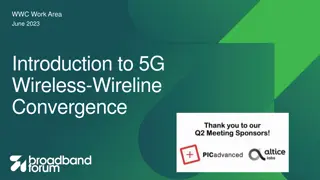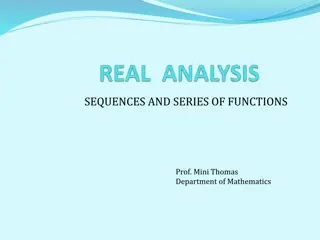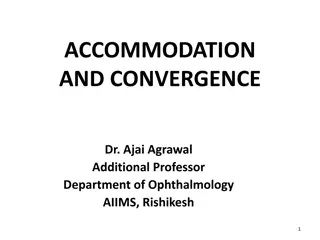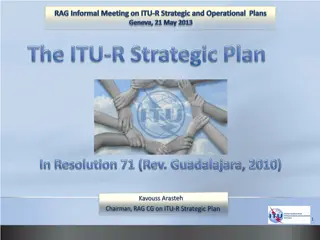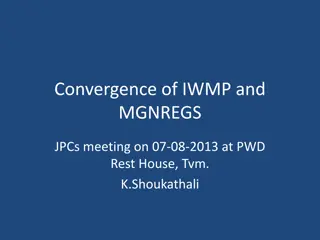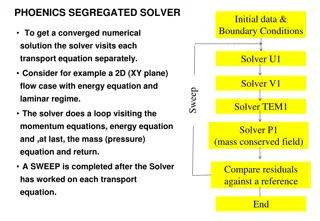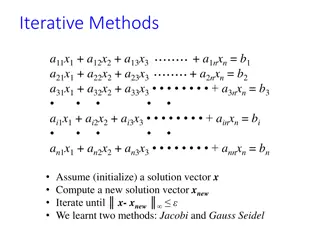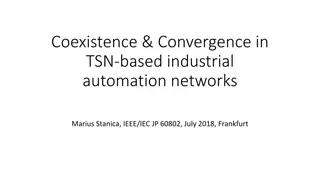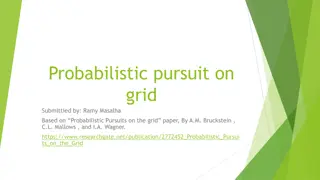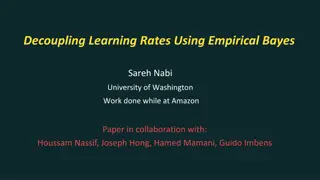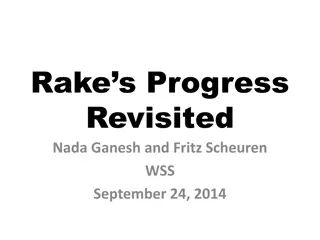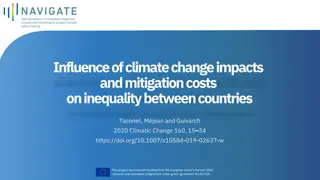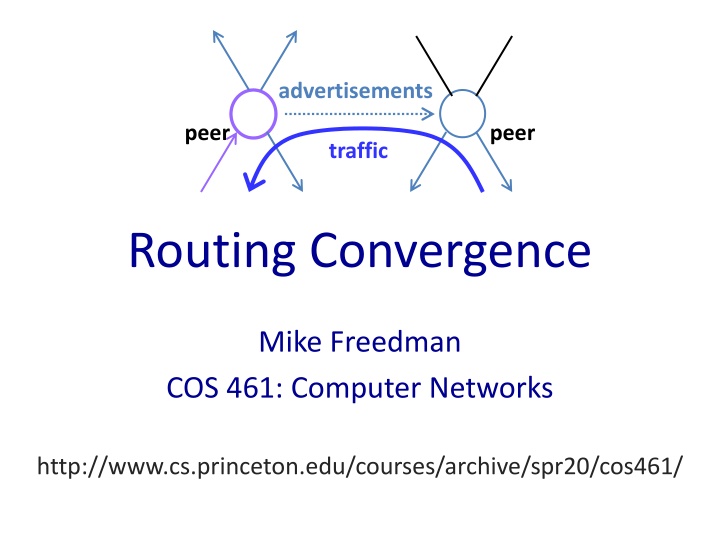
Network Routing Convergence and Topology Changes
Explore the complexities of routing convergence and topology changes in computer networks, including peer traffic, host mobility, planned maintenance, and detecting topology changes. Learn about the control plane, data plane, transient disruptions, and sources of convergence delay. Understand the impact on network performance and potential risks during routing changes.
Uploaded on | 1 Views
Download Presentation

Please find below an Image/Link to download the presentation.
The content on the website is provided AS IS for your information and personal use only. It may not be sold, licensed, or shared on other websites without obtaining consent from the author. If you encounter any issues during the download, it is possible that the publisher has removed the file from their server.
You are allowed to download the files provided on this website for personal or commercial use, subject to the condition that they are used lawfully. All files are the property of their respective owners.
The content on the website is provided AS IS for your information and personal use only. It may not be sold, licensed, or shared on other websites without obtaining consent from the author.
E N D
Presentation Transcript
advertisements peer peer traffic Routing Convergence Mike Freedman COS 461: Computer Networks http://www.cs.princeton.edu/courses/archive/spr20/cos461/
Routing Changes Topology changes: new route to the same place Host mobility: route to a different place 2
Two Types of Topology Changes Planned Maintenance: shut down a node or link Energy savings: shut down a node or link Traffic engineering: change routing configuration Unplanned Failures Fiber cut, faulty equipment, power outage, software bugs, 4
Detecting Topology Changes Beaconing Periodic hello messages in both directions Detect a failure after a few missed hellos hello Performance trade-offs Detection delay Overhead on link bandwidth and CPU Likelihood of false detection 5
Routing Convergence: Link-State Routing 6
Convergence Control plane All nodes have consistent information Data plane All nodes forward packets in a consistent way 2 1 4 1 3 2 1 5 4 3 7
Transient Disruptions Detection delay A node does not detect a failed link immediately and forwards data packets into a blackhole Depends on timeout for detecting lost hellos 2 1 3 1 4 2 1 5 4 3 8
Transient Disruptions Inconsistent link-state database Some routers know about failure before others Inconsistent paths cause transient forwarding loops 2 2 1 1 3 3 1 1 4 4 2 2 1 1 5 4 4 3 3 9
Convergence Delay Sources of convergence delay Detection latency Updating control-plane information Computing and install new forwarding tables Performance during convergence period Lost packets due to blackholes and TTL expiry Looping packets consuming resources Out-of-order packets reaching the destination Very bad for VoIP, online gaming, and video 10
Slow Convergence in Distance-Vector Routing 12
Distance Vector: Link Cost Changes 1 Y Link cost decreases and recovery Node updates the distance table If cost change in least cost path, notify neighbors 4 1 X Z 50 DY = Distances known to Y 13
Distance Vector: Link Cost Changes 1 Y Link cost decreases and recovery Node updates the distance table If cost change in least cost path, notify neighbors 4 1 X Z 50 DY = Distances known to Y 14
Distance Vector: Link Cost Changes 1 Y Link cost decreases and recovery Node updates the distance table If cost change in least cost path, notify neighbors 4 1 X Z 50 DY = Distances known to Y good news travels fast 15
Distance Vector: Link Cost Changes Link cost increases and failures Bad news travels slowly Count to infinity problem! 60 Y 4 1 X Z 50 16
Distance Vector: Link Cost Changes Link cost increases and failures Bad news travels slowly Count to infinity problem! 60 Y 4 1 X Z 50 algorithm continues on! 17
Distance Vector: Poison Reverse If Z routes through Y to get to X : Z tells Y its (Z s) distance to X is infinite (so Y won t route to X via Z) 60 Y 4 1 X Z 50 algorithm terminates 18
Distance Vector: Poison Reverse Can still have problems in larger networks A D C B 1. A and B use ACD and BCD, so A and B both poison to C. 2. But when CD withdrawn (cost goes to infinity), B switches to BACD, so BC no longer poisoned to C. 3. C then starts using CBACD. Loop. 19
Redefining Infinity Avoid counting to infinity By making infinity smaller! Routing Information Protocol (RIP) All links have cost 1 Valid path distances of 1 through 15 with 16 representing infinity Used mainly in small networks 20
Reducing Convergence Time With Path-Vector Routing (e.g., Border Gateway Protocol) 21
Path-Vector Routing Extension of distance-vector routing Support flexible routing policies Avoid count-to-infinity problem Key idea: advertise the entire path Distance vector: send distance metric per dest d Path vector: send the entire path for each dest d d: path (2,1) d: path (1) 3 1 2 data traffic data traffic d 22
Faster Loop Detection Node can easily detect a loop Look for its own node identifier in the path E.g., node 1 sees itself in the path 3, 2, 1 Node can simply discard paths with loops E.g., node 1 simply discards the advertisement d: path (2,1) d: path (1) 3 1 2 d: path (3,2,1) 23
BGP Session Failure BGP runs over TCP BGP only sends updates when changes occur TCP doesn t detect lost connectivity on its own Detecting a failure Keep-alive: 60 seconds Hold timer: 180 seconds AS1 Reacting to a failure Discard all routes learned from neighbor Send new updates for any routes that change AS2 24
Routing Change: Before and After 0 0 (2,0) (2,0) (1,0) (1,2,0) 1 1 2 2 (3,2,0) (3,1,0) 3 3 25
Routing Change: Path Exploration AS 1 Delete the route (1,0) Switch to next route (1,2,0) Send route (1,2,0) to AS 3 0 (2,0) (1,2,0) AS 3 Sees (1,2,0) replace (1,0) Compares to route (2,0) Switches to using AS 2 1 2 (3,2,0) 3 26
Routing Change: Path Exploration (2,0) (2,1,0) (2,3,0) (2,1,3,0) (1,0) (1,2,0) (1,3,0) Initial: All AS use direct Then destination 0 dies All ASes lose direct path All switch to longer paths Eventually withdrawn 1 2 0 How many intermediate routes following (2,0) withdrawal until no route known to 2? 3 (3,0) (3,1,0) (3,2,0) (2,0) (2,1,0) (2,3,0) (2,1,3,0) null 27
BGP Converges Slowly Path vector avoids count-to-infinity But, ASes still must explore many alternate paths to find highest-ranked available path Fortunately, in practice Most popular destinations have stable BGP routes Most instability lies in a few unpopular destinations Still, lower BGP convergence delay is a goal Can be tens of seconds to tens of minutes 28
Stable Paths Problem (SPP) Instance Node BGP-speaking router Node 0 is destination 2 1 0 2 0 2 5 5 2 1 0 2 4 2 0 4 3 0 Edge BGP adjacency 4 0 1 3 3 0 Permitted paths Set of routes to 0 at each node Ranking of the paths 1 3 0 1 0 1 most preferred least preferred 30
Stable Paths Problem (SPP) Instance 1 will use a direct path to 0 (Y) True (M) False 2 1 0 2 0 2 5 5 2 1 0 2 4 2 0 4 3 0 5 has a path to 0 (Y) True (M) False 4 0 1 3 3 0 1 3 0 1 0 1 most preferred least preferred 32
Stable Paths Problem (SPP) Instance 1 will use a direct path to 0 (Y) True (M) False 2 1 0 2 0 2 5 5 2 1 0 2 4 2 0 4 3 0 5 has a path to 0 (Y) True (M) False 4 0 1 3 3 0 1 3 0 1 0 1 most preferred least preferred 33
An SPP May Have No Solution 2 1 0 2 0 2 4 0 3 2 0 3 0 1 3 0 1 0 3 1 3 35
Avoiding BGP Instability Detecting conflicting policies Computationally expensive Requires too much cooperation Detecting oscillations Observing the repetitive BGP routing messages Restricted routing policies and topologies Policies based on business relationships 36
Conclusion The only constant is change Planned topology and configuration changes Unplanned failure and recovery Routing-protocol convergence Transient period of disagreement Blackholes, loops, and out-of-order packets Routing instability Permanent conflicts in routing policy Leading to bi-stability or oscillation 37
Link State: Shortest-Path Tree Find shortest path t to v v 1 y Forwarding table entry at t (Y) (t,x) (M) (t, s) z 1 4 4 1 x u 3 1 5 Distance from t to v (Y) 6 (M) 7 (C) 8 (A) 9 t w 1 2 s Rounds to find shortest path (Y) 5 (M) 6 (C) 7 (A) 8 Rounds: Add s (distance 2), w (distance 3), x (distance 4), z (distance 5), equi-distance to u or y (distance 6) So could be 5 (via y) or 6 (via u then y) 39
Additive Increase/Decrease Fairness Line x1 = x2 AIAD User 2 s Allocation x2 Efficiency Line User 1 s Allocation x1 40
Multiplicative Increase/Decrease Fairness Line x1 = x2 MIMD User 2 s Allocation x2 Efficiency Line User 1 s Allocation x1 41
Additive Increase / Multiplicative Decrease Fairness Line x1 = x2 AIMD User 2 s Allocation x2 Efficiency Line User 1 s Allocation x1 42


